Saturday, June 05, 2004
Billon antoninianus, Gallienus, Siscia, Göbl 1395i
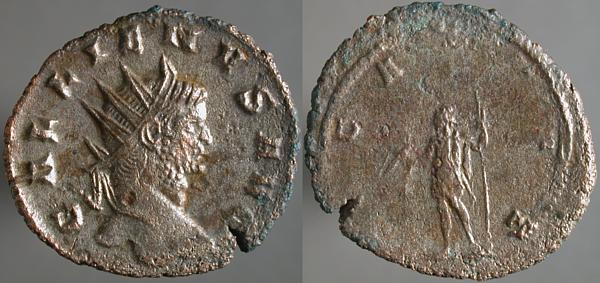
GALLIENVS AVG, Radiate head right | IO CANTAB, Jove Cantabrorum standing facing, head left, holding long scepter right and thunderbolt left.
The coinage of Gallienus isn't famous for innovation, using a fairly small number of reverse types and legends. The "Legionary series" is the first to use the actual badges of the legions, but coins naming the legions were minted centuries before, for Marc Antony, and Septimius Severus issued a similar series at the end of the 2nd century.
The "zoo series", minted towards the end of the reign, features the animal companions, real and mythical, of the Roman pantheon, but there's nothing special about a Roman coin honoring the gods. There's an especially good treatment of that series here.
This, though, featuring the Cantabrian Jove, does seem to be a type issued in no other reign. The figure itself, Jove with scepter and thunderbolt, isn't uncommon, but the legend is.
Friday, June 04, 2004
Æ27, Ancyra in Galatia, Valerian, SNG von Aulock 6188
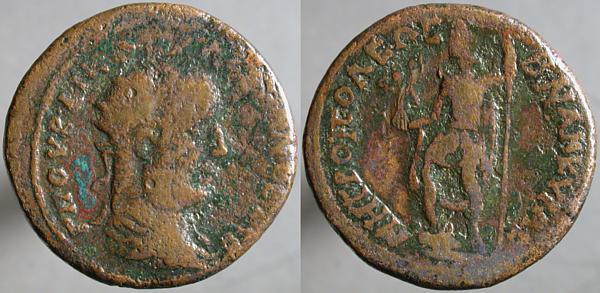
Γ ΠΟVΒ ΛΙΚ [...]ΝΟC CΕΒ, Radiate draped cuirassed bust right | ΜΗΤΡΟΠΟΛΕΩC Β Ν ΑΝΚVΙΑ, Mên standing facing, foot on bucranium, head left, holding spear right and Victory left.
Minted at the site of modern-day Ankara, this coin features the infrequently-seen god Mên. Describing another coin featuring this god, an attributor at CNG says:
"An Anatolian deity of uncertain antiquity, the god Mên was the focus of a thriving local cult in Phrygia and Pisidia in the Hellenistic and Roman period. Numerous shrines and temples dedicated to his worship are found in the region, although inscriptions mentioning the cult have been found as far away as Athens. Mên was one of the High Gods of Anatolia, whose favor was sought for healing, prosperity, and general well-being. He is typically depicted with a crescent moon on his shoulders, thus identifying him as a lunar god observing human affairs from above, and bearing a sceptre."
Thursday, June 03, 2004
Billon antoninianus, Mariniana, Rome, Göbl 220b
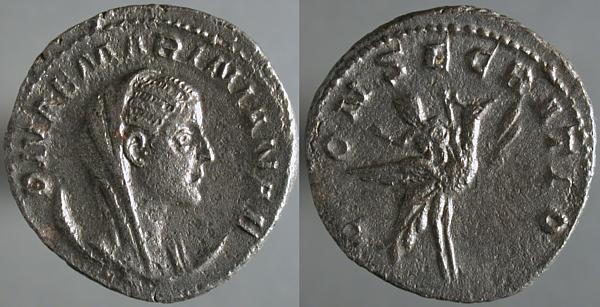
DIVAE MARINIANAE, Veiled draped bust right on crescent | CONSECRATIO, Mariniana, holding a scepter, on peacock flying right.
Quite similar to Monday's coin, but with the peacock flying in the other direction, and with Mariniana holding a scepter instead of that weird big feather.
Wednesday, June 02, 2004
AR tetradrachm, Athens, Sear GCV 2526

Old-style almond-eye head of Athena, helmeted, right | ΑΘΕ, owl standing right, head facing, crescent and olive sprig left.
What a lovely big lump of silver. Many years ago, when I was a kid pushing Lincoln pennies into Whitman folders, my parents bought me a catalog of World Coins with an Athenian tetradrachm on the cover. I certainly didn't know then that they existed outside of museums. They're not cheap, but they're certainly available.
Image hosting for this entry provided by www.ancients.info, which offers free web hosting for non-commercial ancient coin sites.
Tuesday, June 01, 2004
Æ26, Viminacium in Moesia Superior, Mariniana, Sear GIC 4521
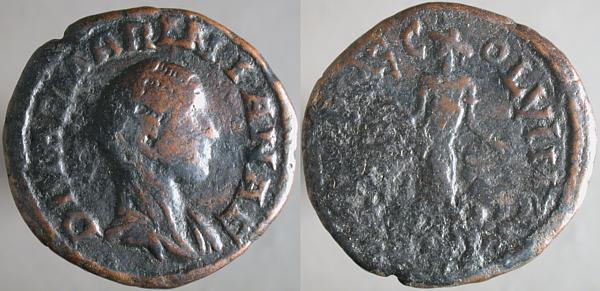
DIVAE MARINIANAE, Veiled draped bust right | P M S C_OL VIM, Moesia standing, head left, with bull right in left field and lion left in right field. AN [XVI?] in exergue.
Yesterday I posted an imperial coin of Mariniana, today the only provincial issue in her name, from Viminacium (today Kostalac). The imperial issues all feature a peacock reverse, but this has the normal reverse for provincial issues of Viminacium: a figure representing the provinces of Moesia standing between the legionary badges of Legio IV Flavia and Legio VII Claudia.
Viminacium also issued an imperial coin for Mariniana, which suggests to me that they were simultaneously issuing imperial gold, billon silver, and minor Æ, and provincial Æ at the beginning of the joint reign Valerian and Gallienus, though both kinds of Æ were soon discontinued.
Monday, May 31, 2004
Billon antoninianus, Mariniana, Rome, Göbl 219b
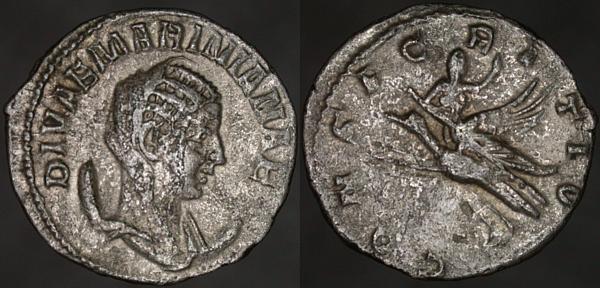
DIVAE MARINIANAE, Veiled draped bust right on crescent | CONSECRATIO, Mariniana, holding a huge feather, on peacock flying left.
All the coins featuring Mariniana, wife of Valerian, show her veiled and name her as divine, so she either died before Valerian became emperor, or just after, before coins were struck.
All the imperial issues show a peacock, which traditionally accompanies Juno, queen of the Roman pantheon. A deified empress is often shown, as here, ascending to the heavens on the back of a peacock.
Sunday, May 30, 2004
Æ30, Thessalonica in Macedonia, Gallienus, see below
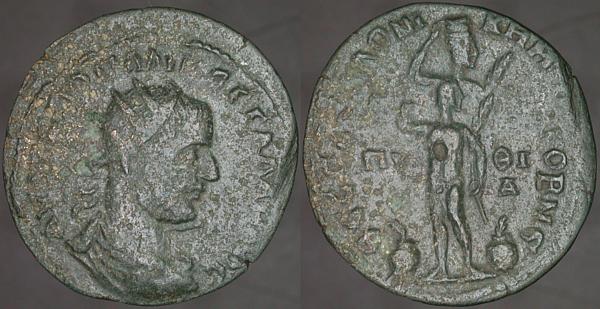
ΑVΤ [...] ΛΙΚ [...] ΓΑΛΛΗΝΟC, Radiate draped cuirassed bust right | ΘΕCCΑΛΟΝΙ_ΚΗ Μ[Η Κ]Ο Β ΝΕ, Athlete standing facing, head right, crowning himself, between two urns with palms protruding, holding palm branch right. (Double strike makes it look like two figures.) ΠΙ_ΘΙ/Α across fields.
Thanks to Curtis Clay, I learned that this coin is cataloged in Touratslogou, Münzstätte von Thessaloniki, p. 309, no. 38, V5, R19, and apparently there's only one other example known.
Getting a coin to strike up properly, so that the design is impressed on it, may require more than one blow of the hammer. This is, naturally, more likely to be needed for large coins, like this 30mm example.
If all goes well, there's no appreciable movement of the coin relative to the dies between those blows. When there is movement, the results can be strange, as can be seen on the reverse here.
The obverse shows less dramatic evidence of the double-strike, too. Particularly beneath the chin, the flattened remains of the first strike can be seen.
My luck, there's two of them in the world and I get the ugly one!

